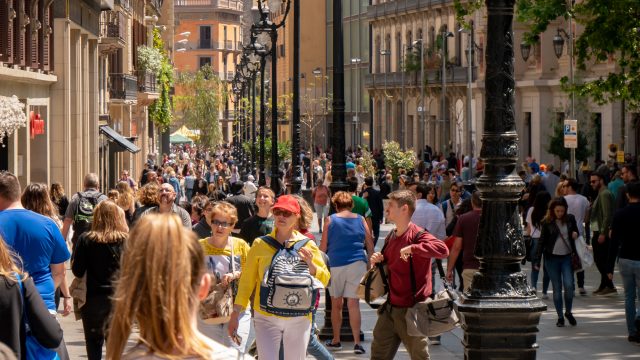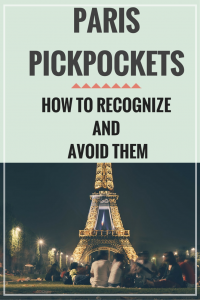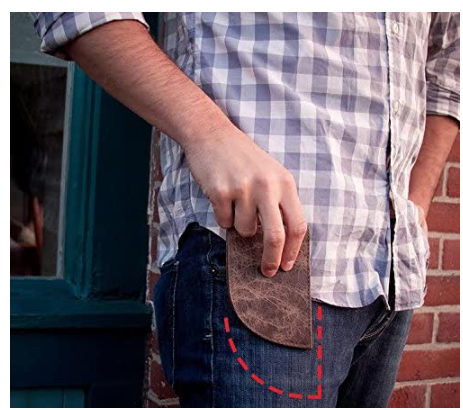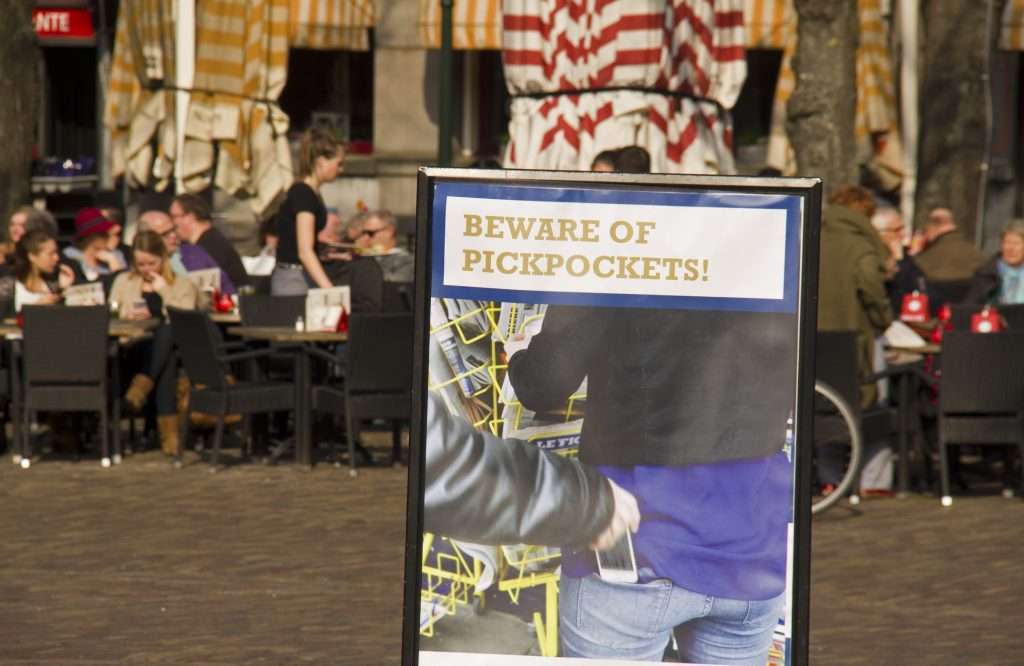With over 2.2 million city residents and millions of tourists, it is easy to see how this crowded city can make a petty thief rich. If you travel there you should know how to avoid pickpockets in Paris. The US Embassy reports that major sites such as the Eiffel Tower, Notre Dame, and the Champs-Elysées are prime hunting grounds for Paris pickpockets who work near these tourist attractions. Additional areas where travelers need to be vigilant of pickpocket scams in Paris include metro trains, monuments, trains, train stations, hotels, airports, and parks.
Where Pickpockets Lurk in Paris
There is never enough time to truly discover Paris. From the breathtaking sites of the Eiffel Tower, Arc de la Triomphe, the Louvre, Sacre Coeur, and to the romantic walkways along the Seine River or narrow streets on the Cité Island, there are many reasons for travelers to explore the Paris to the city limits. Because there is a large concentration of museums, monuments, and parks in proximity, it creates the perfect hunting ground for petty thieves and pickpockets in Paris. The following tourist sites are frequented by pickpockets and other thieves: Madeleine, Arc de Triomphe, Champs, Sacre, L’Opera, George Pompidou Center, Porte de Clingnancourt flea market, and the Eiffel Tower.
Video of Young Paris Pickpockets
Watch this video so you can see what a typical group of young teenage pickpockets looks like when they travel as a group. While they look like an innocent group of kids, trust that they are far from it. Note how they will cover their faces when they see that someone is filming them.
Pickpocket Scams at Paris Museums and Monuments
The following is a list of typical Paris pocket picker scams that are reported around local museums and monuments.
- No place in Paris is safe from the skillful, delicate hand of a pickpocket. While touring the Musee D’Orsay you may notice fellow tourists and even Parisians examining the superb collection of art, including the young, unknown man dressed in khaki trousers, a pink, Polo button-down shirt with a large camera hanging from his neck. You and the man must be walking through the museum at the same pace because he keeps accidentally bumping into you. After viewing the treasures of the museum, you start to make your way out and notice that your bag is unzipped and open. In fact, your wallet is missing. The fellow tourist was not only examining the exhibitions; he was also examining you.
- The Eiffel Tower is probably the area with the most pickpockets and swindlers. The grounds below the tower are open and quite large. In 2009, 6.6 million visitors took in the world-class views from the top deck. With millions of travelers carrying valuables such as money, cameras, purses, etc., it is no wonder that a man would spend his entire day there zipping around on rollerblades and grabbing whatever he can. Because of the rollerblades, he can escape quickly and never be caught.
- There are even small, organized gangs that operate on the Eiffel Tower grounds. They may be selling miniature statues of the Eiffel Tower or other souvenirs. When you try to pay for the trinket, one of the “salesmen” grabs your purse, wallet or waist pack and runs away. Although there is a police presence to protect visitors from these occurrences, the thieves have learned to outsmart the police by throwing the stolen goods from member to member until they disappear.
Solution: If you are interested in purchasing a souvenir from a street vendor, after selecting the item and agreeing on a price, step back from the group; discreetly remove the needed money and return to pay. Try to maintain a distance from the salesmen, so that your items are not within hand’s reach. Also, keep small change for these sorts of purchases separate from your passport and wallet. Do not expect street vendors to make change for you.
Tips to Avoid Pickpockets in Paris
- Always be aware of your surroundings. When observing the sites, make sure to also observe those around you. If you find yourself in a crowded area, such as an elevator, keep an eye or hand on all of your belongings.
- Take only what you need for the day, the rest should stay in your hotel safe or in a portable safe in your room.
- Guard your valuables (passport, credit card, phone) with an anti-theft waist pack or hidden underclothing waist wallet.
- Bring no more cash (Euros) than what you expect to spend and only one credit card, your second backup credit card be stored in your safe.
- If wearing a purse only wear it crossbody style, and make sure it has a locking zipper.
- Do not place anything in your back pocket, only use your front pocket, or better yet use a money belt you tuck into the front of your pants.
Additional Paris Pickpocket Scams
- Most travelers expect thieves to be gangs of men. However, there are also small groups of women who eagerly await the daily arrival of new visitors. A woman or group of women may approach you with a sign or even text on a piece of paper. The text may be in French or even English. While you take a look at what is on the paper, one of the other women will take a look at what valuables you are carrying and grab what they can. This is the classic distraction technique.
- There are many, often long lines to enter the Eiffel Tower. While waiting in line (between 15 minutes and 2 hours), you notice two teenage girls greeting the people in line. They seem very nice and approach you by saying, “Hello”, while gently touching your shoulder from the front. As she touches you from the front, you don’t notice the other girl taking your belongings from behind.
- Once you finally enter the lobby to take the elevators to the top of the Eiffel Tower, you are safe, right? No. Per the Overseas Security Advisory Council, thieves take advantage of the crowded conditions
- A must see is the Louvre. With an exhibition area of 652,300 square feet, you could spend years in the Louvre and still not see everything. In 2008, 8.5 million guests visited the vast collection. Next to the Louvre Place is the Garden of Tuileries, making this a very big tourist attraction. What attracts tourists will always attract pickpockets. University-aged students may attempt to collect signatures for a cause from the hundreds of tourists waiting in line. It seems like a prime opportunity to gather many signatures in a short amount of time. It is also a prime opportunity to be robbed with your hands and eyes occupied with the petition.
- People may also campaign for relief for third-world countries by asking for small donations. Once you stop to learn more, a group of people surrounds you and attempts to lure more money or simply take what they want. This and the previous signature scam can occur all over the city, including The Louvre, Garden of Tuileries and on the Champs-Elysées.
- An iconic site in Paris is the Cathedral of Notre Dame. The cathedral is especially popular for visitors taking a city bus tour. There is a large, open square in front of Notre Dame that provides a fantastic resting place to enjoy the weather and the gothic architecture. While relaxing in the square, a fellow traveler asks if you can help translate a flyer for a café. While you examine the text, his accomplice makes off with your camera bag. This pickpocket method of distraction is performed by men, women, and even small children.
- Once you arrive at Notre Dame, you notice that there is a very long line to enter. You contemplate if you should stand in line, and a person approaches you offering to sell you tickets to enter the cathedral. You purchase two tickets and wait in line only to find out that there is no entrance fee. If you do want to climb the staircase to the top of the cathedral, you can pay at the desk inside the cathedral.
- After taking in the views from the top of the cathedral, you make your way down and exit. As you walk out the door, a blind man bumps into you. You are distracted by the waving of his cane as he tries to find his balance. Later at a café, you realize that your money is missing. The blind man was not blind at all. When he bumped into you, he quickly made a grab for the cash in your pocket.
- Deaf and Dumb Trick. A young or old man or woman approaches you indicating that they are deaf and dumb. She has a clipboard. It looks like a petition. You sign your name. She asks you for money as you just signed a pledge to give a donation. It is written minimum 10 euros. Almost always, the people are not deaf, they just pretend to be – which you may observe if you stand back and watch them for a while. The best response to these types of situations is to say simply”no thank you” and walk away.
Solution: Try to keep a distance from strangers. If someone bumps into you, check your pockets and bags immediately.
More Paris Pickpocket Scams
- Settled on a hilltop in the Montmartre neighborhood is the stunning Basilica of the Sacre Coeur. This is an excellent location to view the city from above, especially when lit at night. While taking a peek inside of the Basilica, a man lightly bumps into you as you are admiring a statue. Startled, you look at the man, and then out of the corner of your eye, you catch the movement of the man’s hand in your purse.
- The steps in front of the Sacre Coeur are a popular hangout for young people and tourists. As you search for a good place to rest on the steps, a man approaches and offers to perform a “let’s be friends” trick. Americans love to be loved and hate to be embarrassed in public, which makes them a perfect target for this type of scam. The man who approached you innocently asks if you’ll help him (or her) with a “demonstration” for other curious tourists. The scammer proceeds to scam artists and tourists make a “friendship bracelet” right on your wrist. But when he’s finished, you’re suddenly and unexpectedly asked to pay for this simple string bracket. Since you can’t easily take it off, you pay up to avoid creating a scene in front of the crowd.
- Another version of the string bracelet being tied around the wrist starts off the same way, but this time you are confused because this is no trick and
- once the bracelet is tied, the man can see if you are wearing a watch and steal it, or a group of friends quickly surround you and demand money for the bracelet, you are forced to “pay-

Thieves and Pickpockets Prey on Tourists in Crowds
up” for the bracelet in order to get your watch back. Stay clear of anyone trying to approach you with the bracelet scam.
- Famous artists such as Claude Monet, Vincent van Gogh, and Pablo Picasso once had studios in the Montmartre neighborhood. Today tourists can still visit the tiny streets and the decadent bistros of this hilltop quarter. A local artist may even approach you offering to sketch a caricature of you. After much convincing, you finally agree. The artist has indeed sketched a very fun portrait, and after he charges you a steep price of 50 Euros.
- You decided to visit the Centre Pompidou to see what the controversy is about – some people find the contemporary style to be an eyesore and some truly appreciate it. You sit down on a bench outside of the center, and another person sits down on the same bench, but behind you and facing the opposite direction. The pickpocket then carefully slides their hands into your jacket pocket and steals everything inside. They then quickly disappear into the crowd.
Solution: When you sit, you cannot feel the weight of your heavy pockets or bags. This makes it easier for a petty thief to take what he wants without you noticing. Try to keep belongings out of sight from others. If this is not possible, hold them in front of you, or in eye’s sight when taking a rest.
Additionally, never purchase anything without agreeing to a price beforehand. There are many pickpockets and swindlers in this area, so beware.
Pickpockets Scams in Paris Neighborhoods and In-between
The city of Paris is split into districts or quarters. Many of these neighborhoods are unique and attract many visitors. The Marais, Les Halles, Latin Quarter, Republique and especially the Pigalle quarter are areas where travelers should pay special attention to their belongings.
- While walking through the streets of “Old Paris” in the Marais quarter, you refer to your travel guide to find directions to Place des Vosges. While studying the guide, a French woman asks if she could look quickly at your book. As the woman examines the map in the book, you realize that another man is standing very close to you. The woman quickly gives back the book and the two walk off together. You inspect your bag and notice that one of the zippers is open, and money is missing.
- The Pigalle is known as the adult entertainment district of Paris. The US State Department reports, “Many entertainment establishments in this area engage in aggressive marketing and charge well beyond the normal rate for drinks. Reports of threats of violence to coerce patrons into paying exorbitant beverage tabs are not uncommon. There have also been several violent confrontations between rival gangs in the district, including one in August 2007 one block from the famous Moulin Rouge cabaret. Visitors are encouraged to avoid this area unless touring with a well-organized and reputable tour company.”
- It is a beautiful, warm summer evening and you decide to walk from Montmartre to the city center via the Pigalle district. When near the Moulin Rouge a man sees you smoking and asks for a cigarette. You give the man a cigarette and another passerby also asks for a cigarette; you give this person a cigarette too. The next morning when you pack your travel pack for the day, you are unable to find your camcorder. Thinking back on the previous evening, you realize that the people who asked for cigarettes were actually working as a team to distract you and steal from you.
- To stroll the streets along the River Seine is a wonderful way to view the splendid bridges of Paris, some even centuries old. Unfortunately, Parisians and tourists are not the only people taking in the sights of the city; pickpockets also work this well-traveled path. A fellow passerby stops to ask you which direction the famous Pont Neuf, the most famous and oldest bridge in the city. You pull out your map to help guide the friendly traveler in the right direction and beneath the map, the traveler has their hands in your bags.
- There are many joggers in Paris; it is a beautiful place to get some exercise. A jogger dressed in a Nike outfit accidentally bumps into you and knocks you down. He apologizes and frantically tries to help you up. He also helps himself to the contents of your pocket. If someone is truly lost and you wish to offer assistance, it may be a better idea to hand over your map, so they can find the location on their own. This allows you to keep an eye on your belongings and pockets, while they find their way. If someone bumps into you, first check to make sure their hands are not on you.
- While walking across Le Pont de l’Archevêché (bridge) a passerby accidentally spills their ice cream cone on your back. The person apologetically stops and pulls out tissues to help you clean off your shirt. While they help clean your shirt, they also help themselves to your back pocket.
- Walking home from a late dinner, you notice a group of 10 or 11-year old kids skating on the sidewalks and clumsily bumping into people. At first, you enjoy watching the children having fun on their rollerblades, but the longer you watch, you see one of the children bump into an old man and swipe the wallet from his back pocket.
- The Overseas Security Advisory Council reports that petty theft can also occur in Parisian department stores such as Galleries Lafayette, Printemps, and Bon Marché. Thieves swipe wallets, credit cards or even passports that customers set on counters when paying.
Pickpockets and Travel Scams at Paris Restaurants and Hotels

- You arrive in Paris exhausted and jet-lagged at 6 a.m. You arrive at your hotel and are unable to check in until 2 p.m., but the hotel agrees to hold your bags until then. You decide to go to a nearby café to try your first, authentic, French croissant and a café au lait. You pay the waiter and then once you leave, you realize that he double charged you. Always check a menu before entering a restaurant or café and always examine the bill at the end of a meal.
- Although there are fast-food chains such as McDonald’s, Subway, and KFC in Paris, these restaurants usually attract American tourists and pickpockets know this. You want a break from the foreign and decide to enjoy a hamburger at one of the surprisingly clean and stylish chains in the city. You sit down at a table, and a few minutes later, another diner asks to share your table. When the man next to you leaves, he grabs his bag and yours as well.
- You decide to eat breakfast at your hotel and take your travel pack with you so you can immediately start your sightseeing afterward. Because the breakfast room is on the lower floor of the hotel, you set your pack on the chair across from you. After you finish eating, you collect your things, but to your surprise, your bag is gone. A thief, pretending to be a guest, snuck into the hotel to take the belongings of unsuspecting travelers.
- After returning from a long day of sightseeing, you return to the room to find that your bags are open and empty, even the socks and undergarments are missing. The only other person who had access to the room was the cleaning staff. You never know where or when you will be the victim of theft. Keep items in your hotel room locked using a luggage lock or a portable travel safe with a padlock.
- The US State Department reports, “In hotels, thieves target lobbies and breakfast rooms, and take advantage of moments of inattention to snatch jackets, purses, and backpacks. While many hotel rooms do have safety latches that allow guests to secure their rooms from inside, this feature is not as universal as it is in the United States. If no chain or latch is present, a chair placed up against the door and wedged under the handle is usually an effective obstacle to surreptitious entry during the night. There are, however, reports of thieves breaking into hotel rooms on lower floors through open windows while the occupants are sleeping. To guard against this, hotel room windows should be kept locked at all times. Whenever possible, valuables should be kept in the hotel safe.”
How to Outfox Pickpockets In Paris – Explore the City like a Local
- Dress like the locals. Parisians typically dress in darker or neutral colors. Shorts, running shoes, baseball caps, and t-shirts scream “tourist.”
- Learn a few French phrases. Parisians are more likely to help you if you make an effort to speak their language.
- Familiarize yourself with the local currency in your hotel room, not in a public square. You can even research the different Euro bills online before leaving home.
- It is great to be patriotic, but try to avoid wearing the US flag on your backpack or clothing. This again indicates that you are a tourist.
- Visit less crowded attractions such as the Musée D’Orsay. The larger Louvre, for example, is always busy with both visitors and petty thieves.
- The Police authorities in Paris have created a safety guide for travelers, Paris – Complete Safety. The guide offers tips on how to avoid becoming a victim and who to contact if theft occurs.
Protect your valuables when traveling from pickpockets. Select one or two different styles of travel security accessories such as an anti-theft waist pack, money belt, passport pouch, or antitheft backpack before you go for peace of mind.











